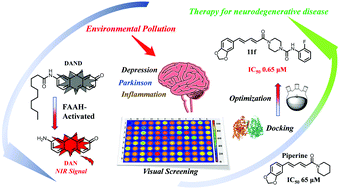A NIR fluorescent probe for fatty acid amide hydrolase bioimaging and its application in development of inhibitors†
Abstract
Fatty acid amide hydrolase (FAAH) is primarily responsible for the inactivation of fatty acid ethanolamide (FAE) and is involved in a variety of biological functions related to diseases of the nervous system. Herein, we developed a highly selective and sensitive FAAH-activated near-infrared fluorescent probe named DAND and achieved the real-time detection and imaging of FAAH activity in complex biosystems. Moreover, a visual high-throughput screening method was established using DAND, piperine was identified as a novel inhibitor of FAAH. Based on the interaction of piperine with FAAH, a more potent FAAH inhibitor (11f) was designed and synthesized which possessed an IC50 value of 0.65 μM. Furthermore, 11f could attenuate the liposaccharide (LPS)-induced activation of BV2 cells, exhibiting an excellent anti-inflammatory activity. These results indicated that DAND could be used as a promising molecular tool for exploring FAAH activity and for rapidly screening potential FAAH inhibitors. In addition, piperine and its derivatives could serve as potential candidate drugs for the treatment of neurodegenerative diseases in the future.



 Please wait while we load your content...
Please wait while we load your content...